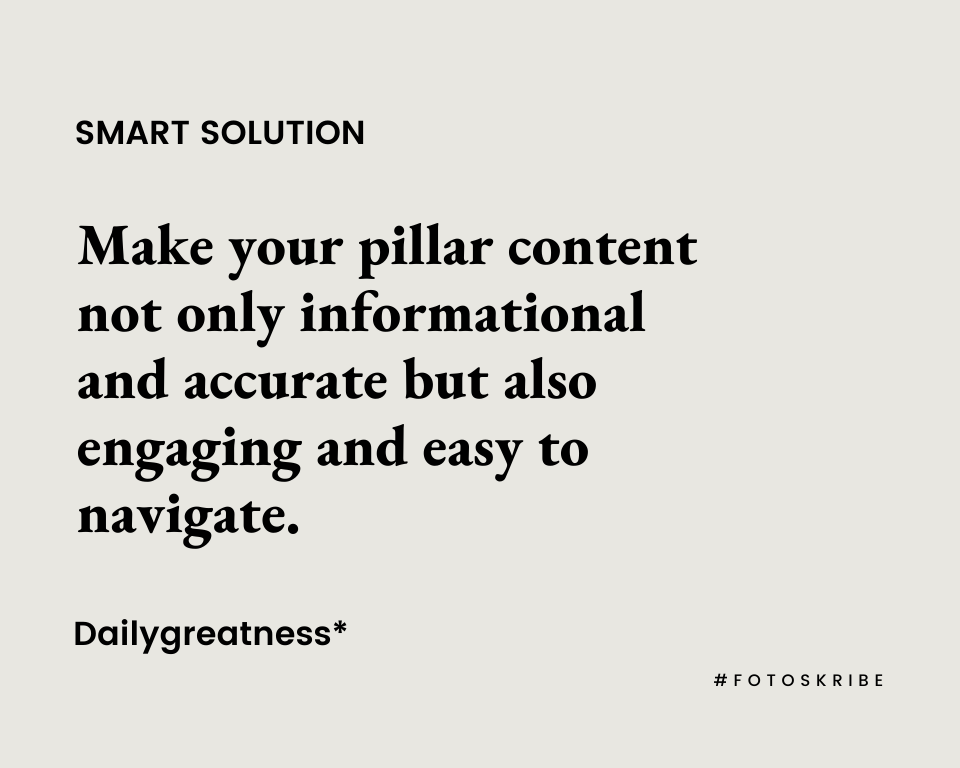Understanding Pillar Content: A Complete Guide
Think about this – when you search for a topic on Google or look for an answer to a specific question, do you prefer to go through blogs that touch upon the subject fleetingly and in an ambiguous manner, leaving you confused, or do you turn to blogs that dive deep into the subject matter – approaching the topic in detail – and back up the information with facts and stats? As web users, a majority of us would go for the second option, and so would Google. Content of this kind is informative and reliable – making it one of the reasons why search engines favor a pillar content page from time to time. Want to learn more about it and how you can use such cornerstone content to improve your search engine ranking? Keep reading!
What Is Pillar Content?

A pillar content page serves as the pillar (or the foundation) of any particular topic or keyword. Instead of briefly covering a topic or subject, a content of this type takes the reader through every sub-category of the topic, looking into it in detail, elaborating on the process, and most importantly addressing questions in an exhaustive manner. Think of it as a complete guide or an informative piece on any topic – something that establishes trustworthiness. It often takes the shape of long-form content and doesn’t necessarily have to be in the outline of a blog. However, remember, bigger isn’t always better; the idea is not to write more, but to write something of value.
Think of pillar content as the trunk of a broader category to which every other related sub-category blog posts (also called cluster content) are linked as branches. The two main goals of this type of content are to rank better on a search engine result page (SERP) and to provide readers value. In addition to the written format, a pillar page could also include information in the format of infographics and videos.
Suggested Read: Guides, eBooks, And Infographics: Getting More Mileage Out Of Your Images
Different Types of Pillar Pages
A pillar page can serve many purposes, and therefore even though the backbone or the core of such pages remains quality information, there could be different types of such content. Given below are the three different types of pillar content:
- Guides: Guides form an extensive account of information on any topic. They are built to tell everything that there is to know about a respective topic of discussion and talk from the point of view of a subject matter expert. Moreover, they can also take the shape of an e-book or anything in a downloadable format.
- ‘How-to’ and ‘what is’ pages: Similar to guides, these too are information-centric pages. However, they might not come in the shape of an e-book or something that could be downloaded. Moreover, these serve specific purposes. They do talk in length about the question asked but might not always be as comprehensive as guides. They mostly stick to the focus of the topic, be it a process, a solution, or any other similar form.
- Service of product-centric page: Just as the name suggests, a product or service-centric pillar page puts the focus on a specific product or service that your business offers. Content of this kind tells the readers more about the service, how it can be availed, and how it can help them.
Suggested Read: Republishing Blog Posts: What’s the Need & How to Do It
How To Create Pillar Content
1. Choose A Broader Topic Of Interest

The process of creating a pillar page starts from brainstorming a topic of interest. And that accounts for a lot – because it can’t be anything random; instead it has to be well-thought-out. So think of something that is not only a substantial element of your business but also something that you would want your business website to rank for. Try not to think in terms of keywords at first, rather think in terms of the topic. A broader category (but not too vast or vague) that defines your major product or service, or something you have subject matter expertise in and have knowledge about. Once you zero in on a topic, then you can start narrowing it down to finding relevant focus keywords.
However, if you find yourself struggling to think of a relevant topic to build your cornerstone content on, then perhaps spend more time getting to understand your market and your audience. What is your target audience most eager to learn about, what’s trending in the market, or what is that one service that drives money to your business? In addition to that, also analyze your competitors. Closely monitor what pillar content your competitors have been putting out. However, if you still need some help, there are various tools such as SEMrush and Ubersuggest that can help you zero in on your topic of interest.
2. Choose The Focus Keyword
Keyword research is an integral part of any content marketing strategy, even more so for creating successful pillar content. Instead of rushing through this part, we suggest you give it some time. It is better to make multiple changes at first than to realize you got the foundation of your pillar wrong. To begin with, start by making a note of some of the popular, high-volume, keyword options for your topic. Analyze their keyword complexity, and if need be, you could even think of alternative keywords and analyze them. To make this process easier, you can make use of various keyword research tools such as Moz, Ahrefs, SEMrush, and Ubersuggest, and then review the results. Along with deciding on the main keyword, also note down a cluster of related long-tail keywords and latent semantic indexing keywords. These will be the topics that you can further expand on.
3. Create Quality Content

It is a no-brainer! The pillar article, as well as everything else that it links to, needs to be of premium quality. These pages should be curated in a way so that they are not only informational and accurate but also engaging and easy to navigate. Right from the content matter to the structure, everything either builds your page better or downgrades its value. Whether you aim for it to be a lead generator or a subscribers-only content, to make it stand out, it has to be thought through meticulously.
Here are some pointers for the writing process:
- Do in-depth research on your topic: Remember, you are here to provide a viewpoint of an expert or build a platform of trust. And it won’t happen if the information is vague or inaccurate. So go through several resources and gather everything you need before you begin writing.
- Build a structure: Now that you have an idea of where to begin from and what goes where, put that into paper. Start with building an outline structure of your blog and make pointers to additional information. This might take a few more minutes, but it will save you a lot of hassle during the writing process.
- Follow the structure and write: Now that you have an outline of your blog, all you have to do at this point is just write. While you are writing your first draft, steer clear of multiple editorial notions. At this juncture, just write and pour it all out.
- Support your information with stats: To build trust, support your notion or information with relevant facts and stats from trusted sources. And as you do so, don’t forget to analyze whether it is a trustworthy source or not. The final point – link to the source.
- Put on the editing hat: No matter how good you think your first draft is, don’t make it your final. Let it either pass through the scrutiny of an editor, or put on the editing hat yourself. Don’t hesitate to strike off stuff that doesn’t add value to the piece.
- Don’t be ambiguous: Long-form content can be beneficial – but not if they are just lengthy without giving any relevant information. So try to be precise and accurate and avoid doing a series of questions that you have no answer to. In the end, the reader wants a takeaway.
Related Read: 5 Reasons to Outsource Content Writing for a Photography Business
4. Incorporate Relevant Internal Links
You have written a great piece. Awesome! But unless you cleverly incorporate relevant internal links in your copy, your blog won’t be dynamic enough and be able to explore its full potential. A good internal linking strategy can help your pillar content link juice flow to other important pages of your website as well. Link to the cluster content that adds value to your page. You could either add these links to the content or build a separate section where you link to topic clusters as the answer to common queries for your current page, or you could add them as a supporting element in the form of ‘also read’, ‘read more’, etc.
The Perks Of Creating A Pillar Page

Now that you have a better understanding of what’s pillar content and how to create it, check out some of the benefits of creating a pillar page:
- Improves Google Ranking: One of the main perks of a pillar page is that it improves the chances of getting a higher ranking on SERP for a specific keyword owing to many factors such as multiple backlinks, quality content, etc. And this could lead to a higher visibility rate.
- Streamlines Navigation: Other than higher ranking, pillar pages also help to create a streamlined navigation flow for different pages of your website. So people who visit your website can easily navigate through different web pages. The same goes for web crawlers.
- Increases Trustworthiness: Gaining the trust of your readers and target audience is one of the perks of well-thought-out pillar pages. It does not just benefit you but also the audience who is seeking the answer to that specific question or searching for that topic. And by providing high-quality well-researched and accurate content through the medium of these pages, you end up creating a platform people can rely on.
- Increases Engagement: These pages often work as a pioneer information outlet for a particular topic, and, therefore, are often widely shared on all the various platforms. This not only helps your website gain more backlinks but also increases engagement and page views, and can decrease bounce rate.
Suggested Read: 6 Types Of Interactive Content To Impress & Engage Audience
Creating Quality Content Takes Time

Creating quality content that stands out from the heap of content already available on the same topic takes both time and effort. But the fruit of it is totally worth it! Many of us want our businesses to be perceived as a trusted source for our core expertise in the eyes of our target audience, all the while generating sustainable traffic from that content. However, building that trust and gaining that traffic take a lot more than simply scribbling down something random. If you still feel a little lost, try asking yourself this, “Is the content I’m creating adding any value to my audience?” If not, then all you need to do is gather your energy and divert your time and efforts to creating effective pillar content that stands out. Research, assimilate, write, edit, and evaluate – following these steps could eventually help you lay the foundation of your ideal pillar page.
Further Read: Understanding the Silo Structure & How It Can Benefit Your Website
At Fotoskribe, we aim to help businesses like yours grow their online presence by delivering smart and meaningful content that engages your audience. And we do it in a way that gets Google’s attention.
For more information on how we can help – check out our pricing plans.

